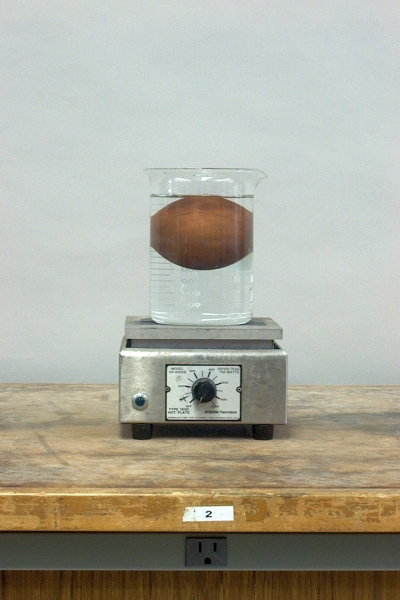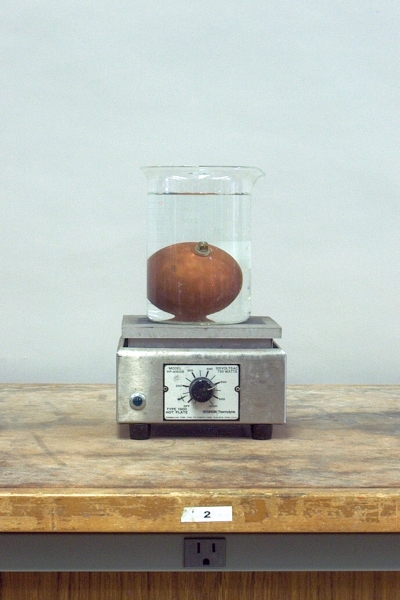 |
 |
In the beaker above is a hollow copper sphere, about three inches (76 mm) in diameter, filled with just the right amount of sand to make its density such that it floats in water that is room temperature or below, but sinks in water that is at about 40 °C or above. In the photograph at left, the water in the beaker is fresh from the tap. In the photograph at right, the water has been heated to the point where the ball has sunk. Starting with fresh tap water and then heating it until the ball sinks takes about 13-1/2 minutes. If you wish to perform the demonstration more quickly, you can start with a beaker of fresh tap water, and a second, preheated beaker, and transfer the ball from one to the other. Placing a few ice cubes in the warm beaker, and placing the beaker on a cold pack causes the ball to float again after perhaps about five minutes.
Demonstrations 36.34 – Diet vs. regular Coke, 36.36 – Archimedes’ principle, 36.37 – Cartesian divers, 36.39 – Helium-filled balloon, and also 36.33 – Balls in beans, all illustrate the buoyant force that an object experiences when it is submerged in a fluid. (The balls in beans demonstration is a special case that shows that beans, which are granular, can behave as a fluid under the right conditions.) For the helium-filled balloon and Archimedes’ principle demonstrations, the densities of the fluid and the submerged object are fixed. In the Cartesian diver demonstration, squeezing one of the containers allows you to change the density of the diver inside, in one case by forcing fluid into it, and in the other by reducing its volume. For the Diet vs. regular Coke demonstration, you have the option of increasing the density of the fluid by adding salt to the tank, thus causing the initially sunk can of Coca-Cola to float. In this demonstration, the copper sphere described above is submerged in a beaker of water, and by changing the temperature of the water (either by heating or cooling, or by switching the sphere to a beaker that has water of a different temperature from that of the water in the first beaker), you change its density, and thus the buoyant force experienced by the copper sphere. In cool water, this buoyant force just exceeds that of gravity, and the sphere floats. Warm water (40 °C or greater, as noted above) is not dense enough – the weight of the water displaced by the sphere no longer equals that of the sphere – and the sphere sinks.
It is true that the sphere expands slightly as you raise its temperature. This expansion, however, is tiny. Over the range 0 °C to 100 °C, α, the coefficient of linear expansion, for copper is 17 × 10-6/C°, which gives a change in volume of 51 × 10-6/C° (3α). Over the range from 20 °C to 60 °C, the coefficient of volumetric expansion for water ranges from about 207 × 10-6/C° to about 523 × 10-6/C°, four to ten times that for copper. (At 40 C, it is about 385 × 10-6/C°, or about 7.5 times that for copper.)
References:
1) Resnick, Robert and Halliday, David. Physics, Part One, Third Edition (New York: John Wiley and Sons, 1977), pp. 467-469.
2) Weast, Robert C., Editor. Handbook of Chemistry and Physics, 51st Edition ( Cleveland, Ohio: The Chemical Rubber Company, 1970), p. F-5.